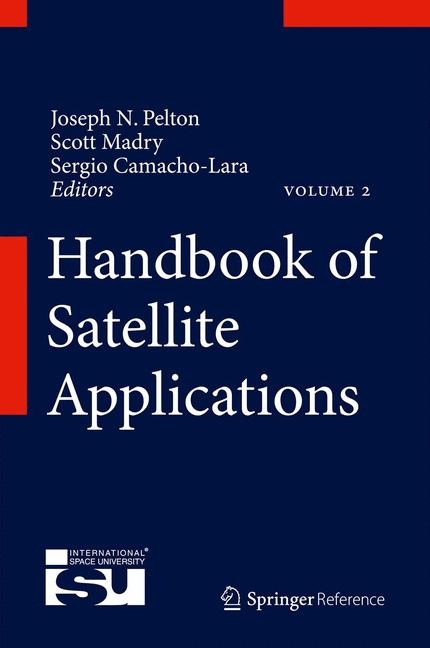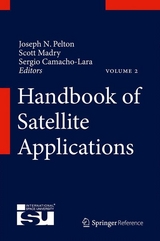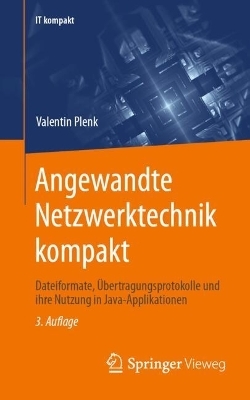Handbook of Satellite Applications
Springer-Verlag New York Inc.
978-1-4419-7670-3 (ISBN)
- Titel erscheint in neuer Auflage
- Artikel merken
Top space experts from around the world have collaborated to produce this comprehensive, authoritative, and clearly illustrated reference guide to the fast growing, multi-billion dollar field of satellite applications and space communications. This handbook, done under the auspices of the International Space University based in France, addresses not only system technologies but also examines market dynamics, technical standards and regulatory constraints. The handbook is a completely multi-disciplinary reference book that covers, in an in-depth fashion, the fields of satellite telecommunications, Earth observation, remote sensing, satellite navigation, geographical information systems, and geosynchronous meteorological systems. It covers current practices and designs as well as advanced concepts and future systems. It provides a comparative analysis of the common technologies and design elements for satellite application bus structures, thermal controls, power systems, stabilization techniques, telemetry, command and control (TTC), and orbital configurations.
These common aspects are addressed in an integrated fashion to explain how all these space systems share similar design features, but also have quite specialized application packages to carry out their various missions. No other reference in print today provides such a comprehensive and in-depth guide to all forms of application satellites, including small sats as used by countries just beginning space application programs.
Dr. Joseph N. Pelton, former Chairman of the Board and Dean, International Space University, former Executive Director, Space & Advanced Communications Research Institute (SACRI), George Washington University, former Director of Strategic Policy, Intelsat, Founder, Arthur C. Foundation, Founding President of the Society of Satellite Professionals Internationals (SSPI), Fellow, International Association for the Advancement of Space Safety, Full Member, International Academy of Astronautics, Author/editor of some 30 books including a Pulizer Prize nomination for the work Global Talk. Dr. Scott Madry; Geospatial Data Scientist, Renaissance Computing Institute, and also holds a Research Faculty Appointment with the Department of Anthropology at the University of North Carolina. He currently serves as faculty member and department chair of Satellite Applications for the International Space University. He is a former Academic Council member, International Space University, former Associate Director of the Center for Remote Sensing and Space Spatial Analysis at Rutgers University. Former Senior Project Manager, the Institute for Technology Development, Space Remote Sensing Center, NASA Stennis Space Center. Dr. Sergio Camacho-Lara; Secretary General, Regional Center for Space Science and Technology Education for Latin America and the Caribbean, affiliated with the United Nations, and former Director, United Nations Office of Outer Space Affairs, full member, International Academy of Astronautics and Co-Chair of its Commission V. Chairman, World Space Week Association, Co-Chair Action Team on Near Earth Objects of the United Nations Committee on the Peaceful Uses of Outer Space.
Chapter 1: Satellite Applications Handbook: The Complete Guide to Satellite Communications, Remote Sensing, Navigation, and Meteorology.- Chapter 2: Satellite Communications Overview.- Chapter 3: History of Satellite Communications.- Chapter 4: Space Telecommunications Services and Applications.- Chapter 5: Satellite Orbits for Communications Satellites.- Chapter 6: Fixed Satellite Communications: Market Dynamics and Trends.- Chapter 7: Satellite Communications Video Markets: Dynamics and Trends.- Chapter 8: Mobile Satellite Communications Markets: Dynamics and Trends.- Chapter 9: An Examination of the Governmental use of Military and Commercial Satellite Communications.- Chapter 10: Economics and Financing of Communications Satellites.- Chapter 11: Satellite Communications and Space Telecommunications Frequencies.- Chapter 12: Regulatory Process for Communications Satellite Frequency Allocations.- Chapter 13: Satellite Radio Communications Fundamentals and Link Budgets.- Chapter 14: Satellite Communications Modulation and Multiplexing.- Chapter 15: Satellite Transmission, Reception and On-Board Processing Signaling and Switching.- Chapter 16: Satellite Communications Antenna Concepts and Engineering.- Chapter 17: Satellite Antenna Systems Design and Implementation Around the World.- Chapter 18: Satellite Earth Station Antenna Systems and System Design.- Chapter 19: Technical Challenges of Integration of Space and Terrestrial Systems.- Chapter 20: Satellite Communications Regulatory, Legal and Trade Issues.- Chapter 21: Trends and Future of Satellite Communications.- Chapter 22: Introduction to Satellite Navigation Systems.- Chapter 23: Global Navigation Satellite Systems: Orbital parameters, time and space reference systems and signal structures.- Chapter 24: International Committee on GNSS.- Chapter 25: Current and Future GNSS and their Augmentation Systems.- Chapter 26: Introduction and History of Space Remote Sensing.- Chapter 27: Electromagnetic Radiation Principles and Concepts as Applied to Space Remote Sensing.- Chapter 28: Astronaut Photography: Handheld Camera Imagery from Low Earth Orbit.- Chapter 29: Electro-optical and Hyper-spectral Remote Sensing.- Chapter 30: Operational Applications of Radar Images.- Chapter 31: Libar Remote Sensing.- Chapter 32: Digital Image Acquisition: Preprocessing, and Data Reduction.- Chapter 33: Digital Image Processing: Post- Processing, and Data Integration.- Chapter 34: Remote Sensing Data Applications.- Chapter 35: Geographic Information Systems and Geomatics.- Chapter 36: Introduction to Space Systems for Meteorology.- Chapter 37: United States Meteorological Satellite Program.- Chapter 38: EUMETSAT Geostationary Meteorological Satellite Programs.- Chapter 39: International Meteorological Satellite Systems.- Chapter 40: Overview of the Spacecraft Bus.- Chapter 41: Telemetry, Tracking, and Command (TT&C).- Chapter 42: Lifetime Testing, Redundancy, Reliability and Mean Time to Failure.- Chapter 43: Ground Systems for Satellite Application Systems for Navigation, Remote Sensing and Meteorology.- Chapter 44: Common Elements versus Unique Requirements in Various Types of Satellite Applications Systems.- Chapter 45: Launch Vehicles and Launch Sites.- Chapter 46: Orbital Debris and the Sustainability of Space Operations.- Chapter 47: Space Weather and Hazards to Application Satellites.- Appendix 1: The World's Launch Sites.- Appendix 2: Major Launch Systems Available Globally.- Appendix 3a: Global Communication Satellite Systems.- Appendix 3b: US Domestic Communications Satellite Systems.
| Reihe/Serie | Handbook of Satellite Applications | 1.10 |
|---|---|
| Zusatzinfo | 92 black & white illustrations, 361 colour illustrations, biography |
| Verlagsort | New York, NY |
| Sprache | englisch |
| Maße | 155 x 235 mm |
| Gewicht | 2320 g |
| Themenwelt | Mathematik / Informatik ► Informatik ► Netzwerke |
| Naturwissenschaften ► Geowissenschaften ► Geografie / Kartografie | |
| Naturwissenschaften ► Physik / Astronomie ► Angewandte Physik | |
| Technik ► Fahrzeugbau / Schiffbau | |
| Technik ► Luft- / Raumfahrttechnik | |
| Technik ► Nachrichtentechnik | |
| Schlagworte | Earth observations • geographic information systems • Geometsat systems • Geosynchronis meteorology satellites • Satellite antennas and communication |
| ISBN-10 | 1-4419-7670-1 / 1441976701 |
| ISBN-13 | 978-1-4419-7670-3 / 9781441976703 |
| Zustand | Neuware |
| Haben Sie eine Frage zum Produkt? |
aus dem Bereich





